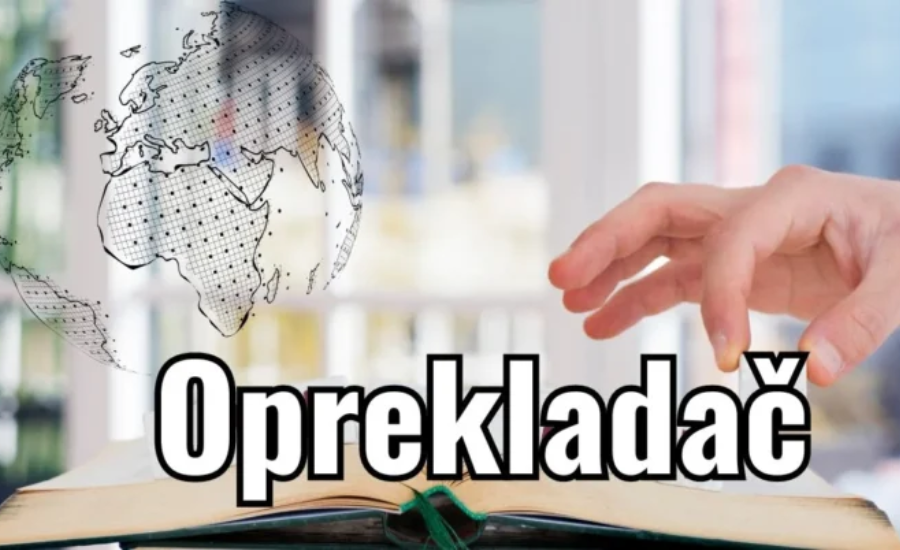Exploring the Revolutionary Potential of Oprekladač
Imagine having the ability to break down language barriers effortlessly. This is the promise of oprekladač, a revolutionary tool that is transforming how we communicate across different languages. By leveraging advanced technology, oprekladač enables seamless translation, making it easier than ever to understand and be understood, regardless of the language spoken. This tool not only enhances personal communication but also has profound implications for businesses, education, and international relations. Whether you are traveling, conducting global business, or simply connecting with people from diverse backgrounds, oprekladač offers a reliable and efficient solution to overcome language obstacles.
The benefits of oprekladač are vast and varied. It provides real-time translation, ensuring that conversations flow naturally without the need for pauses or misunderstandings. This can lead to more effective collaboration and stronger relationships. Additionally, oprekladač is designed to be user-friendly, making it accessible to everyone, regardless of their tech-savviness. Its applications extend beyond just translating spoken language; it can also translate written text, making it an invaluable tool for reading foreign documents, websites, or literature. With oprekladač, the world becomes a smaller, more connected place, where language is no longer a barrier but a bridge to greater understanding and cooperation.
Understanding Oprekladač
An oprekladač is far more than just a translation tool; it’s a bridge that connects individuals from diverse linguistic backgrounds. At its essence, an oprekladač is an advanced piece of software or a device designed to translate text or speech from one language to another both accurately and swiftly. It leverages sophisticated algorithms and cutting-edge technology to ensure that translations are rendered with remarkable precision, making it easier for people to communicate seamlessly, no matter what language they speak.
The true power of an oprekladač lies in its ability to break down barriers and foster understanding between people from different cultures. It doesn’t just translate words; it captures the nuances and context of conversations, providing translations that are not only accurate but also meaningful. This capability transforms interactions, whether for personal communication, business negotiations, or educational exchanges, into more effective and enriching experiences. With an oprekladač, the world becomes a more interconnected and inclusive place, where language differences no longer stand in the way of human connection and cooperation.
Understanding the Functionality of an Oprekladač

The magic of an oprekladač lies in its complex yet efficient operation. By employing a combination of natural language processing and machine learning techniques, an oprekladač analyzes input text or speech, breaking it down into linguistic components. It then generates corresponding translations in the desired language. This process involves recognizing context, grammar, and cultural nuances to produce translations that are both contextually accurate and culturally sensitive.
To understand it better, think of an oprekladač as a multilingual wizard. You input a sentence in one language, and it transforms it into another language seamlessly, without missing a beat. It’s like having a personal translator in your pocket, ready to assist you anytime, anywhere. With an oprekladač, you can navigate conversations in different languages effortlessly, bridging communication gaps and making global interactions smoother and more effective.
Advantages of Using Oprekladač for Translation
The adoption of oprekladač brings numerous advantages that enhance communication across different languages. Firstly, it offers instantaneous translations, eliminating the wait time traditionally associated with language barriers. Whether in personal conversations or professional settings, oprekladač enables seamless communication by providing real-time translations, ensuring interactions flow smoothly without delays.
Secondly, oprekladač excels in accuracy and consistency. Unlike human translators who may inadvertently introduce errors or inconsistencies, oprekladač relies on sophisticated algorithms that are continuously refined. This technological precision results in translations that are not only accurate but also consistent across various contexts, whether it’s translating text or interpreting speech.
Thirdly, oprekladač proves to be a cost-effective solution for both businesses and individuals. By reducing or eliminating the need to hire professional translators, it significantly cuts down on translation costs. This cost efficiency is particularly beneficial for businesses engaged in international operations or individuals who frequently communicate across language barriers. Moreover, by streamlining translation processes, oprekladač saves valuable time that can be allocated to more productive tasks, further enhancing overall efficiency.
In essence, oprekladač revolutionizes communication by overcoming linguistic barriers swiftly, accurately, and economically. Its ability to deliver instant, precise translations fosters smoother interactions and facilitates broader global engagement, making it an indispensable tool in today’s interconnected world.
Types of Oprekladač and Their Applications
Oprekladač is available in various forms, each tailored to different needs and preferences. First, there’s the web-based oprekladač accessible through internet browsers, providing flexibility and convenience. Users can access translations from any device with internet connectivity, making it ideal for quick and on-the-go translation needs.
Next, mobile oprekladač apps are designed for smartphones and tablets, offering portability and ease of use. These apps often include additional features like offline translation capabilities and voice recognition, enhancing their utility for users who need translations while traveling or in areas with limited internet access.
For professionals and businesses, desktop oprekladač software offers advanced functionalities and customization options. It’s designed to integrate seamlessly into existing workflows, allowing for efficient management of translation tasks. This type of oprekladač is particularly suited for organizations that require precise and reliable translations as part of their daily operations.
In summary, whether accessed through the web, mobile apps, or desktop software, oprekladač adapts to diverse user needs, providing solutions that enhance communication across languages in various contexts. Each form offers unique benefits, from accessibility and portability to advanced features tailored for professional use, making oprekladač a versatile tool for bridging language barriers effectively.
Versatility of Oprekladač Across Different Platforms
Oprekladač is available in different forms, each designed to cater to specific preferences and requirements. Firstly, there’s the web-based oprekladač, accessible via internet browsers, offering flexibility and convenience. This type allows users to access translations from any internet-connected device, making it ideal for quick and on-the-go translation needs.
Mobile oprekladač apps are another option, tailored for smartphones and tablets to provide portability and ease of use. These apps often come with additional features such as offline translation capabilities and voice recognition, enhancing their usefulness, especially in situations where internet access is limited or unreliable.
For professionals and businesses seeking more robust capabilities, desktop oprekladač software is available. This version offers advanced functionalities and customization options, integrating seamlessly into existing workflows. It’s particularly beneficial for organizations that require precise and dependable translations as part of their daily operations.
In essence, whether accessed through the web, mobile apps, or desktop software, oprekladač adapts to diverse user needs, facilitating effective communication across languages in various scenarios. Each form offers distinct advantages, from accessibility and mobility to sophisticated features tailored for professional use, underscoring oprekladač’s role as a versatile tool for bridging language barriers comprehensively.
Applications of Oprekladač in Various Fields

The versatility of oprekladač spans across a wide range of industries and everyday situations. Firstly, in the realm of travel and tourism, it serves as a valuable companion for travelers navigating foreign destinations. Whether deciphering signs, menus, or engaging in conversations in unfamiliar languages, oprekladač ensures smoother interactions and enhances the overall travel experience by bridging language barriers effortlessly.
In the business world, oprekladač plays a crucial role in facilitating effective communication across international borders. It enables seamless interactions between business partners, clients, and stakeholders from different linguistic backgrounds. By providing accurate translations in real-time, oprekladač supports collaboration, negotiation, and the exploration of new market opportunities, thereby driving business growth and expansion on a global scale.
Furthermore, in education and learning environments, oprekladač enriches language learning experiences for students and educators alike. It grants access to a wealth of educational resources in various languages, making learning materials more accessible and promoting cross-cultural understanding. This accessibility not only enhances language acquisition but also encourages cultural appreciation and global awareness among learners.
In essence, whether in travel, business, or education, oprekladač serves as a versatile tool that transcends language barriers, promoting connectivity, understanding, and collaboration across diverse industries and scenarios. Its ability to facilitate clear and accurate communication in multiple languages makes it indispensable in today’s interconnected world.
Oprekladač vs. Traditional Translation Methods: A Comparative Overview
Modern automated translation methods offer a highly efficient and rapid alternative to traditional human translation. They significantly outpace the speed of manual translation, enabling quick communication and swift information exchange. This is particularly beneficial in scenarios requiring immediate responses or updates, where traditional methods might lag.
Furthermore, scalability is a strong suit of automated translation. These systems can handle vast volumes of translation tasks simultaneously, meeting diverse needs without any compromise in quality. This makes them ideal for businesses and organizations dealing with large-scale, multilingual content regularly.
Lastly, automated translation proves to be more cost-effective compared to hiring human translators, especially for routine or repetitive tasks. The reduction in labor costs makes it a budget-friendly option for many, allowing resources to be allocated more efficiently without sacrificing the accuracy of translations.
Maximizing the Effectiveness of Automated Translation Tools
To maximize the effectiveness of an automated translation tool, it is crucial to provide clear and concise input. Ambiguity and complex language structures can lead to misinterpretation, so it’s best to use straightforward and unambiguous text or speech. This ensures that the translation software can process the information accurately and deliver a precise output.
Despite the efficiency of automated translation tools, reviewing and refining the translated content is essential, especially for critical communications. Automated systems can swiftly produce translations, but they may occasionally miss context or nuances. Taking the time to review the output helps to ensure that the translation is not only accurate but also coherent and contextually appropriate.
Additionally, exploring and utilizing the customization options available within the translation tool’s settings can significantly enhance the translation experience. By tailoring the settings to meet your specific preferences and requirements, you can achieve more accurate and relevant translations. Customization allows you to adjust the tool to better suit the particular nuances of the languages and dialects you are working with, ultimately improving the overall quality of the translations.
Challenges and Limitations of Automated Translation Tools
Despite its impressive capabilities, automated translation tools are not without their challenges and limitations. One significant issue is their ability to understand contextual nuances and idiomatic expressions. While these tools are highly advanced, they can still struggle with interpreting context-specific details, which can lead to inaccuracies, especially in complex or specialized content. For instance, literary works or technical documents often contain subtleties and jargon that automated systems might misinterpret, resulting in less accurate translations.
Another challenge faced by automated translation tools is cultural sensitivity. These tools may have difficulty capturing and conveying the subtle cultural references and connotations that are often integral to the meaning of the text. Cultural nuances are deeply embedded in language and can be easily overlooked by machines, leading to translations that might miss the essence of the original message or misrepresent cultural contexts.
Additionally, complex language structures can pose problems for automated translation systems. Languages with intricate grammatical rules or convoluted syntax can lead to translations that are less fluent or sound awkward. Automated tools might struggle to navigate these complexities, resulting in translations that are grammatically incorrect or fail to convey the intended meaning effectively. This limitation is particularly evident when dealing with languages that have elaborate sentence structures or numerous grammatical exceptions.
Practical Applications and Benefits of Automated Translation Tools
Real-life examples vividly demonstrate the practical applications and benefits of automated translation tools in various scenarios. For instance, multinational corporations are increasingly relying on these tools to enhance communication across their global offices. By using automated translation, businesses can streamline interactions between teams in different countries, enabling efficient collaboration and supporting their efforts to expand into new markets. This approach not only helps in overcoming language barriers but also contributes to smoother and more effective international operations.
Educational institutions also make significant use of automated translation tools in cultural exchange programs. These tools facilitate meaningful interactions between students from different linguistic backgrounds, allowing them to communicate effortlessly and engage in enriching cross-cultural experiences. Through automated translation, students can break down language barriers, participate in discussions, and build connections with peers from around the world, all of which enhance the educational and cultural value of these programs.
Additionally, automated translation tools prove invaluable for international travelers. A solo traveler exploring foreign cities can depend on these tools to navigate unfamiliar environments, communicate with locals, and fully immerse themselves in new cultures. By translating signs, menus, and conversations, these tools help travelers overcome language obstacles, making their journeys more enjoyable and accessible. This practical application of automated translation enhances the overall travel experience and broadens the opportunities for cultural exploration.
Future Prospects for Oprekladač Technology
As technology continues to advance, the future of automated translation holds exciting and promising developments. One of the most anticipated advancements is the enhancement of artificial intelligence integration. Future improvements in AI technology are expected to produce more sophisticated translation models that can achieve human-like accuracy and fluency. These advancements will allow automated systems to better understand the nuances of language, provide more contextually appropriate translations, and handle complex language structures with greater precision.
Another significant future development is the expansion of multimodal translation capabilities. Emerging technologies are set to integrate features like image and voice recognition, enabling automated translation tools to process and translate a wider range of input types. This will greatly increase the utility of these tools, allowing them to interpret text from images, translate spoken conversations in real-time, and cater to diverse communication needs across various contexts. Such advancements will make automated translation tools even more versatile and accessible for different applications.
Finally, the future of automated translation will see increased cross-linguistic collaboration among linguists, technologists, and AI researchers. This collaborative approach will drive innovation in translation technology, fostering a deeper understanding and more effective communication across different languages. By bringing together experts from various fields, these efforts will lead to the development of new solutions and technologies that enhance global communication and bridge linguistic divides. This collective progress will pave the way for more advanced and inclusive translation tools in the future.
FAQs About Oprekladač Technology
Q1. What is Oprekladač and how does it work?
A1. Oprekladač is an advanced translation tool using natural language processing and machine learning to bridge language barriers. It accurately translates text or speech by analyzing context, grammar, and cultural nuances, enhancing communication between different linguistic backgrounds.
Q2. What are the main benefits of using Oprekladač?
A2. Oprekladač offers real-time translations for seamless communication, is user-friendly for all tech levels, handles spoken and written translations, and is cost-effective, reducing reliance on professional translators and saving time.
Q3. How does Oprekladač compare to traditional translation methods?
A3.Compared to traditional methods, Oprekladač offers faster, more efficient translations that keep pace with conversations. It can handle large volumes of tasks simultaneously and is cost-effective for repetitive translations, reducing expenses compared to human translators.
Q4. What are some common challenges associated with using Oprekladač?
A4. Despite its advanced features, Oprekladač faces some challenges. One major issue is contextual understanding; automated tools might struggle with idiomatic expressions or specialized content. Another challenge is cultural sensitivity, as these tools may overlook subtle cultural nuances or references. Lastly, complex language structures can sometimes result in translations that are less fluent or awkward, particularly for languages with intricate grammar rules.
Q5. What are some real-life applications of Oprekladač?
A5. Oprekladač is used in various real-life scenarios. For global business expansion, multinational corporations use it to facilitate communication across international offices and support market growth. In cultural exchange programs, educational institutions employ Oprekladač to enable students from different backgrounds to interact and learn from each other. For international travel, solo travelers use Oprekladač to navigate foreign cities, communicate with locals, and enjoy a richer travel experience.
Conclusion
In conclusion, Oprekladač represents a revolutionary advancement in translation technology, offering seamless communication across diverse languages. With its real-time capabilities, user-friendly interface, and ability to handle both spoken and written translations accurately, Oprekladač not only breaks down linguistic barriers but also enhances global connectivity and collaboration. As it continues to evolve, its impact on personal interactions, business operations, education, and international relations promises to make our world more interconnected and inclusive than ever before.






